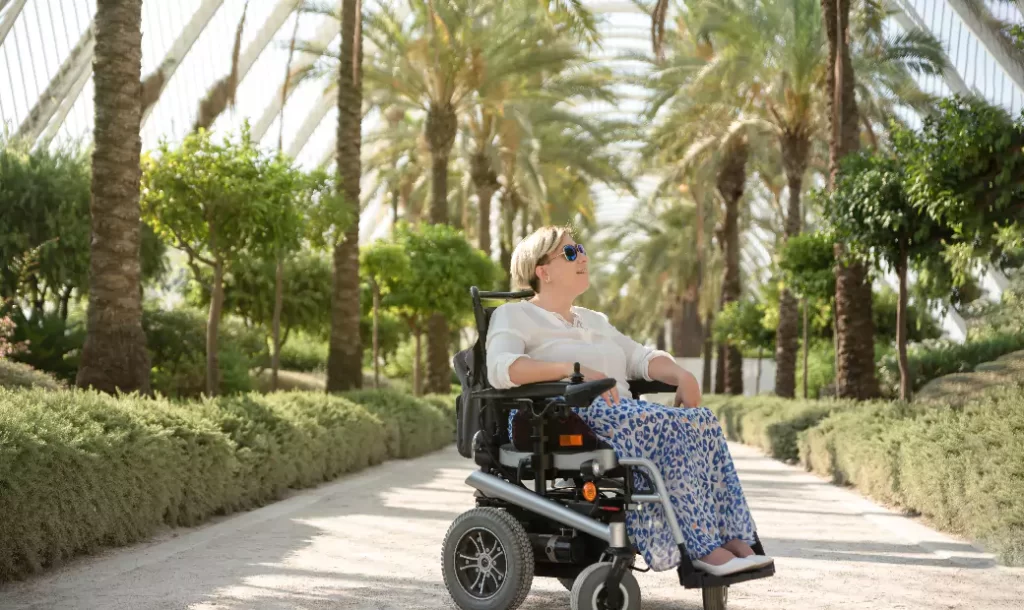Contact Us
Choosing the Right Wheelchair Type for Daily Needs
2025-10-23
Selecting the right wheelchair is not merely a matter of comfort—it is about enhancing independence, safety, and overall quality of life. For hospitals, rehabilitation centres, long-term care facilities and mobility equipment distributors, understanding the various wheelchair types and how each aligns with specific user-profiles and operational requirements is essential.

Understanding the Purpose of Wheelchairs
Wheelchairs are assistive mobility devices designed to support individuals who have limited or no ability to walk. They can be categorised by propulsion mode (manual vs powered), frame structure (folding vs rigid), adjustability (tilt, recline, standing), and terrain or usage context (indoor, outdoor, transport). Choosing the “right type” depends on several factors: the user’s mobility level, environment of use, duration of use, and budget. For B2B buyers—such as hospitals or equipment suppliers—a comprehensive understanding of these factors enables better procurement decisions, improved end-user satisfaction, and manageable maintenance cycles.
Manual Wheelchairs
Manual wheelchairs are propelled either by the user (via large rear wheels) or by an attendant (via handles). They are simpler in design, lower in cost, and relatively easier to maintain—making them widely used across institutional settings.
Standard / Folding Manual
This is the most common configuration: steel or aluminium folding frame, fixed armrests, footrests, often in hospital or outpatient settings. These chairs suit patients who are able to self-propel or be pushed for short distances. From a procurement perspective, institutions often keep a fleet of these chairs for general use, guest use, outpatient transfers and transport.

Lightweight / Active Manual
For users with higher mobility goals—such as independent community outings or transport with minimal staff assistance—lightweight or ultra-light manual wheelchairs make sense. These typically use aluminium frames (or even carbon fibre in premium models), have quicker “setup” time, removable parts (wheels, footrests), allowing easier shipping or vehicle transport. From a distributor’s viewpoint, lightweight manual chairs allow a higher-spec offering for users demanding independence.
Rigid Frame Manual
In settings where the user is highly active (sports, long-distance self-propelling) or the facility wants to offer premium options, rigid-frame manual chairs are chosen. Because the frame does not fold, the energy transfer from user to wheel is more efficient. For B2B customers, this means higher unit cost and more training/support needed, but may allow premium billing or rental segments.
Electric (Powered) Wheelchairs
For individuals with limited or no upper body strength, or those requiring longer distance travel or independent community mobility, powered wheelchairs are essential. These chairs use batteries and motors, controlled via joystick or alternative interface, and often provide tilt/raise/recline functions.
Standard Electric Models
These are built for stability, comfort, and everyday use. They include padded seats, adjustable armrests, intuitive controls, and sometimes suspension for uneven terrain. From a facility or distributor perspective, powered chairs represent higher ticket items, more warranty/maintenance support, and may require infrastructure (charging stations, storage space). They often appeal in long-term care settings, user home-use programs or rental fleets.
Lightweight / Foldable Electric Models
A growing trend is portability in powered chairs—models that fold or disassemble for ease of transport (e.g., in a vehicle) or tight storage environments (apartments). For B2B buyers, offering such models gives competitive differentiation: combining power mobility with flexibility of transport and storage. However, selection must ensure battery life, braking safety, and service availability.

Transport (Transit) Wheelchairs
Transport wheelchairs—or companion chairs—are a subclass of manual wheelchairs designed exclusively for being pushed by attendants rather than self-propelled. They typically have smaller rear wheels, narrower frames, and are made to fold quickly for transit. These are frequently used in hospitals, airports, hotels, and day-programs.
From a business standpoint, transport chairs serve high-turnover use: short trips, guest use, discharge preparation, or rental programmes. They allow lower per-unit cost, simpler maintenance (no large drive wheels), and easy deployment. However, they are not suited for long-term daily use by independent users.
Reclining / Tilt-in-Space / Standing Wheelchairs
These specialty wheelchairs address advanced posture, pressure-relief or therapeutic mobility needs.
-
Reclining chairs allow the backrest to tip backwards, reducing pressure and allowing users who cannot sit upright for long periods.
-
Tilt-in-space chairs keep the seat angle constant while tilting the whole seat-back system, shifting weight distribution without changing hip angle.
-
Standing wheelchairs allow users to move into upright standing position, improving circulation, bone health and enabling social engagement.
For B2B purchasers such as long-term care facilities, rehabilitation clinics or CRT suppliers, these chairs command premium pricing, require clinical assessment, and often fall into Complex Rehab Technology (CRT) funding segments. Selecting the right chair here must align with clinical protocols, documentation and maintenance/regulation frameworks.
Travel / Lightweight / Specialty Wheelchairs
While some overlap with lightweight manual chairs, the emphasis here is portability and special usage contexts: frequent travel, vehicle transport, community outings, or rental fleets. These chairs fold very compactly, may be made for airplane/air-travel check-in, or for caregivers needing extra mobility support.
For distributors or rental programmes, showcasing travel-friendly wheelchair options broadens product range. For purchasing facilities, having a subset of chairs dedicated to transportation or outing use reduces wear on “daily-use” stock and improves lifecycle management.
Matching the Right Wheelchair to Daily Needs: A B2B Decision Framework
When your client (hospital, care facility or mobility distributor) is selecting wheelchair types for daily operations, consider the following decision axes:
User Mobility & Strength Profile
-
Can the user self-propel a manual chair? If yes → consider manual self-propel chairs (standard, lightweight, rigid). If no → consider transport or powered chair.
-
Does the user have sufficient upper-body strength or endurance?
-
Do they require advanced posture support (tilt, recline, standing)?
-
Are they independent or do they require caregiver/attendant support?
Environment of Use
-
Indoors only (corridors, lifts) vs outdoors (ramps, uneven terrain)
-
Transport requirements: must the chair fold for vehicle/van transport?
-
Storage and infrastructure: is there charging/parking for powered chairs?
-
Space constraints and turning radius.
Frequency and Duration of Use
-
Occasional or guest use (transport chairs, travel chairs) vs full-time daily use (standard manual, powered, specialist)
-
Community vs inpatient environment.
-
How long will the user spend in the chair each day? Long-duration use increases demands on comfort and posture support.
Maintenance & Total Cost of Ownership
-
Manual chairs: lower cost, fewer moving parts, simpler maintenance.
-
Powered chairs: higher upfront cost, batteries, motors, controls; need service contract, spare parts.
-
For renting or fleet use: how many units, how many users, replacement cycle, spare-unit strategy?
-
Review supplier support, parts availability, warranty, training for staff.
Regulation, Funding & Procurement Channels
-
In many markets, classification of wheelchair (standard DME vs CRT) affects funding, reimbursement and procurement processes.
-
For B2B suppliers/distributors: lead-time, stock planning for speciality models, documentation support.
-
For facilities: align procurement with equipment management policies, replacement cycles, service tracking.
User Comfort, Posture & Quality Outcomes
-
For long-term users, comfort and posture support matter: seat width/depth, back height, arm/leg rests.
-
Preventing secondary complications (pressure ulcers, shoulder fatigue) influences choice of type (e.g., tilt/recline, powered).
-
For bariatric users: correct width, weight-capacity, frame reinforcement matters.
How INTCO Medical Products Fit into a B2B Mobility Strategy
As a manufacturer and supplier, INTCO Medical offers a portfolio of mobility equipment that aligns with many of the above categories. For B2B customers—hospitals, care facilities, equipment distributors—INTCO presents several advantages:
-
Broad product range: INTCO’s wheelchair lines span standard manual chairs, lightweight/active models, electric models and specialty chairs. This allows customers to standardise on one supplier across multiple wheelchair types.
-
Customisation & modularity: For example, INTCO’s ACTIVE sport wheelchair offers backrest angle adjustment and anti-tip features; its E-LITE power wheelchair offers foldable back and detachable cushion for transport-friendly powered mobility. This flexibility allows providers to cater to both general-purpose users and high-spec independent users.
-
Durability and cost-effectiveness: For bulk procurement (e.g., hospitals needing multiple transport chairs or rental fleets), INTCO offers reliable value-oriented models that meet institutional requirements without excessive luxury. This keeps total cost of ownership manageable.
-
Supplier reliability & service: For distributors/resellers, having a single brand like INTCO simplifies SKUs, spare-part sourcing, training materials and aftermarket service. This consistency benefits service-level commitments to downstream customers.
Implementation Checklist for Your B2B Clients
When advising clients on procurement, this checklist helps ensure comprehensive planning:
-
User profiling – How many users are independent vs caregiver-propelled vs power-chair required?
-
Usage model – Inpatient vs outpatient vs community use; frequency of transfers.
-
Storage/transport logistics – Can chairs fold, stack, fit vehicles?
-
Maintenance plan – Service contract, spare-parts inventory, cleaning/sterilisation protocols (for hospital use).
-
Replacement cycle – What is the planned lifecycle of the chair? (e.g., 3 yrs, 5 yrs for heavy-use fleets).
-
Risk management – Are chairs rated for bariatric users? Do tilt/incline chairs help minimise pressure ulcer risk?
-
Funding/regulation alignment – Ensure chosen chair type aligns with funding categories (DME vs CRT) and procurement policy.
-
Supplier selection – Evaluate brand support, spare-parts lead time, training materials, customisation options.
-
Cost modelling – Beyond purchase price: consider maintenance, repair labour, downtime cost, replacement tyres/wheels.
-
User training – Provide training for caregivers / self-users on safe operation, folding/unfolding, self-propulsion technique.
-
Data tracking – For fleets, implement usage logs, incident reports, maintenance logs so procurement team can rationalise stock and replacements.
Summary
Selecting the right wheelchair type is a strategic decision for your business-customers. A poor match between user, environment and chair type can lead to increased operational costs, reduced user satisfaction and higher staff burden. By segmenting wheelchair types into categories (manual self-propelled, transport/companion, powered, tilt/recline/standing, travel/lightweight) and applying key selection criteria (user strength profile, environment of use, frequency, maintenance and cost), B2B procurement professionals can craft a balanced portfolio.
A manufacturer like INTCO Medical offers a strong value proposition—covering standard fleet models for general use through to higher-spec chairs for demanding users—with consistent supplier support. For you as a B2B advisor, distributor, or procurement manager, choosing the right mix of wheelchair types and matching them with the right supplier enables better outcomes for users, more efficient operations, and stronger supplier relationships.
References
-
AliMed. (2023, June 13). How to purchase the right wheelchair. AliMed Blog. Retrieved from https://www.alimed.com/blogs/durable-medical-equipment/how-to-purchase-the-right-wheelchair
-
Broda Seating. (2024, December 27). How to choose a wheelchair: What to consider before buying. Broda Tips – Blog. Retrieved from https://brodaseating.com/blog/wheelchair-questions-you-need-to-ask
-
Eclipse Mobility. (2025, April 18). 7 types of wheelchairs for everyday use & specialized needs. Eclipse Care Blog. Retrieved from https://eclipse.care/types-of-wheelchairs-for-everyday-use-specialized-needs/
-
HONEST Med. (2025, January 14). Wheelchair Guide – Types, selection, maintenance, and more. HonestMed Blog. Retrieved from https://blog.honestmed.com/an-essential-wheelchair-guide-types-selection-maintenance-and-accessories/
-
CME Corp. (2024, December 3). Comprehensive wheelchair buying guide for healthcare facilities. CME Corp Blog. Retrieved from https://blog.cmecorp.com/comprehensive-wheelchair-buying-guide-for-healthcare-facilities


